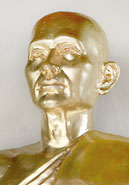Recalling Thailand’s greatest gift to Sri Lanka
This year Esala full moon poya day which falls tomorrow, marks the 260th anniversary of the establishment of the Siam Upasampada in Sri Lanka. This was after the European colonisation of Sri Lanka’s coastal region, especially through the destruction by the Portuguese, the Buddhist Sangha had declined to its lowest ebb. The then Sri Lankan king, Vijaya Rajasinha was looking for a country where the Sangha in its pure form existed to assist him to purify the Sangha in Sri Lanka.

Ven. Upali Mahathera
At the request of his ministers and the Samanera Saranankara, the king sent two missions to Thailand to secure monks for a proper ordination ceremony. Those who were on the first mission were shipwrecked. In response to the second mission, the Thai king did not send monks as the Sri Lanka king had died by then. The next Sri Lankan king Kirti Sri Rajasingha sent a mission to king Boromokot, requesting him to send Thai monks to purify the Sri Lanka Sangha.
Kirti Sri Rajasingha’s mission of five ambassadors arrived in Ayuththaya the Siam capital on July 8, 1751. The ambassadors, who were received with great honour, had an audience with the Thai king, as well as with the Sangharaja. They also participated in Buddhist festivals, such as kathina, and visited important shrines.
The subsequent Thai mission to Sri Lanka included 20 Mahatheras headed by the Ven. Upali Maha Thera and 8 Samaneras (novices). The Siam King bade farewell personally to the envoys as they left Ayuththaya on November 6 or 7, 1751 in a grand procession. This procession carried a golden Buddha image, Dhamma books and a royal message written in Pali and various kinds of gifts to the king of Sri Lanka. From the Siam harbour, the Thai envoys, together with the leader of the Sri Lankan mission left in a Thai ship, while the Sri Lankan ambassadors left in the same Dutch ship in which they had arrived in Siam. The Siamese ship met with an accident in Ligor (present day Nakhon Si Thammarat in Malay Peninsula), and the envoys went back to Ayuththaya at the request of king Boromkot. They returned to Ayuththaya on June 21, 1752.
Another Thai ship was arranged by the king, and the mission left Ayuththaya on December 15, 1752. It included 18 Thai monks, headed by Upali Maha Thera and 7 Samaneras. The mission consisted of 74, including 5 ambassadors, an officer in charge of gifts, 2 translators, 4 physicians (including 2 masseurs), 5 musicians, clerks, cooks, soldiers, and servants. They arrived in Kandy on July 12, 1753. The king of Sri Lanka welcomed the Thai Mahatheras in great reverence, and took them in a grand procession to Malwatta Vihara. where they resided.
On the Esala full moon day of July 20 1753, six Lankan monks, including the scholar monk Ven. Welivita Saranankara Thera, the initiator of the event, and the abbots of Malwatta Vihara and Asgiri Vihara received upasampada from the Thai monks. The Thai monk Upali Mahathera acted as their Upajjhaya (preceptor), while Brahmajoti Mahathera and Mahapunna Mahathera served as Kammavaca (ecclesiastical guides). This marked the establishment of the Siyam or Siyamopali sect in Sri Lanka, which continues to be the most prominent up to the present day.
After the upasampada ceremony, the Thai monks worshipped the Sacred Tooth Relic in Kandy at a special exposition. Thereafter, they went on pilgrimage to worship the Buddha’s Footprint at Samantakuta, and the most important shrines such as the Sri Maha Bodhi and the Mahaceti, both at Anuradhapura.
King Boromkot was far-sighted, so he had planned to send three missions of Thai monks to Sri Lanka within a period of ten years, so that those monks who received upsampada could confer upasampada on others. The team of Thai monks headed by Upali Mahathera worked hard towards this end. They performed, not only all ecclesiastical acts such as vassa, kathina and sima (demarcation of boundaries of the Uposatha hall) ceremonies, but they also made every effort to ensure that the Sri Lankan monks learnt the performance of these acts. They travelled a great deal around the country, and performed the sima ceremonies at many Sri Lankan monasteries, so that Sri Lankan monks could perform the ecclesiastical acts in different regions.
The two Thai Mahatheras, Mahanama and Brahmassara were entrusted with 24 Sri Lankan monks to train Sri Lankans in Vidarsana meditation. Thus they made a firm footing for the re-establishment of the Sangha in Sri Lanka. The Siamese were making a return gift to Sri Lanka for it was the Sri Lankan monks that had established Buddhism in Thailand and other South East Asian countries in the centuries before the destruction by the Portuguese.
Follow @timesonlinelk
comments powered by Disqus


